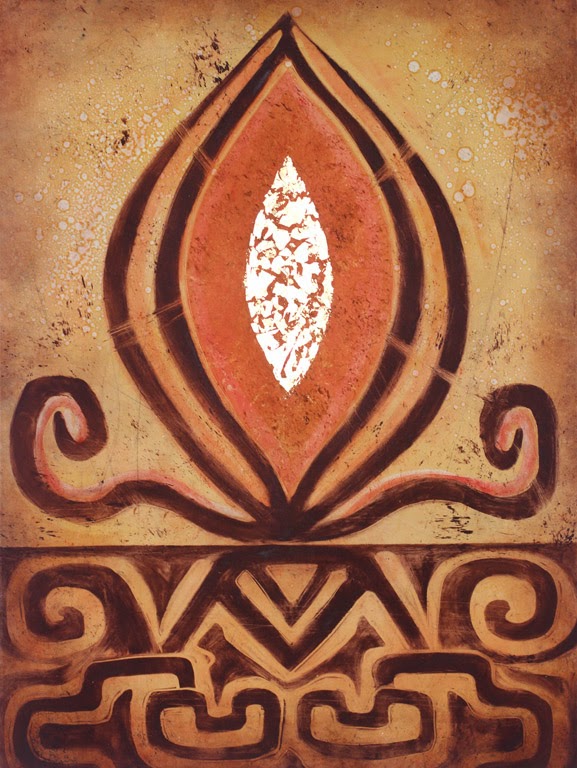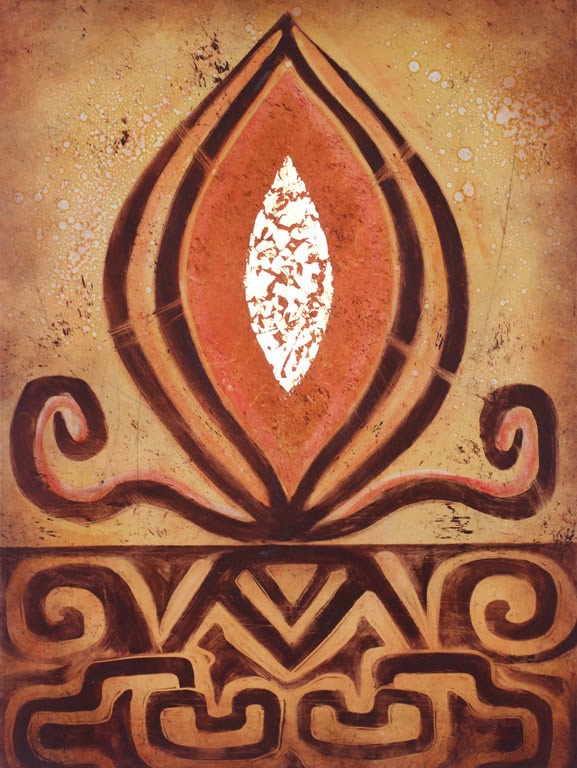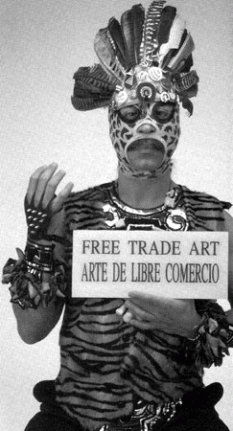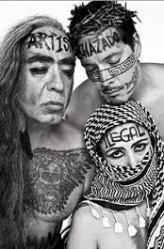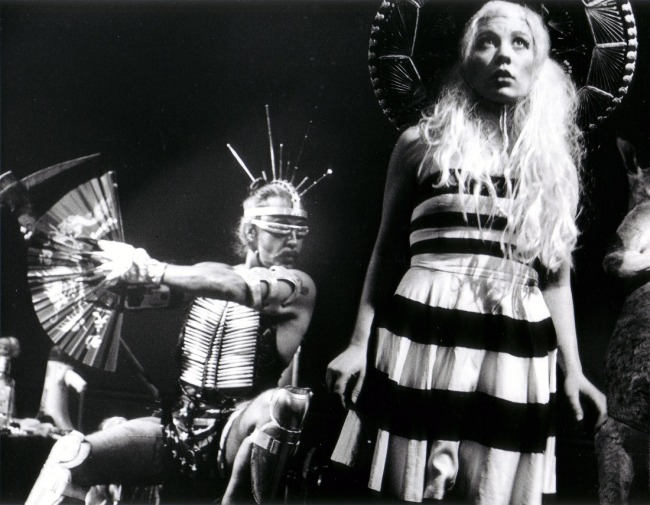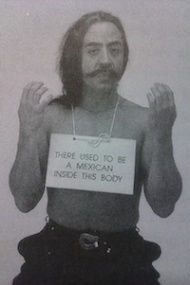one who appears like a brown chalupa nightmare who invites dialog, exchange even consolidation among the races the generations the classes the sexes the senses be taken at face/FATE value? This harpie/ brujo/ shaman in wrestler’s El Santero mask and skin-tight mariachi garb tattooed to a fare-thee-well intoning operatic baritone incantations in feathered headdress or acid-trip sombrero best kept at arms-length defies the branding as an exotic, an eccentric, a novelty by means of politically sound compassionate reasoning, the humor of logic despoiled the of-the-minute sensibility full of wisdom and the skewed normality that passes for the status quo ?
The subject is the border of mind and heart; of boundaries that separate the land and the men and women and thought of it and in it and ring a cash register or pull a trigger or lock a cell door; metal and mental. A western sensibility an American on-going crime.
A meal not easily digested, attractive all the same.
Gómez-Peña has spent many years developing his unique solo style, “a combination of embodied poetry, performance-activism and theatricalizations of postcolonial theory.” In his ten books, as in his live performances, digital art, videos and photo-performances, he pushes the boundaries still further, exploring what’s left for artists to do in a repressive global culture of censorship, paranoid nationalism and what he terms “the mainstream bizarre.” Gómez-Peña examines where this leaves the critical practice of artists who aim to make tactical, performative interventions into our notions of race, culture and sexuality.
In an excerpt from “New World Border” which we read in class, he discusses how he would ideally want the bordered world to disintegrate and become borderless and more mixed on many levels. His conceptual map of the New World Border is “a great trans- and intercontinental border zone, a place in which no centers remain. It’s all margins meaning there are no “others,” or better said, the only true “others” are those who resist fusion, mestizaje, and cross-cultural dialogue.” This quote is particularly interesting because he is voicing his opinion about separations, and judgments made based on borders in society. Peña would prefer a world where there are no “others” who are left out of categories or cultures because they don’t fit the specific criteria or beliefs. He instead, wants there to be a free mixture of cultures, and a feeling of togetherness and inclusion, where only those who are negative towards the blend are left out because of their close-mindedness. He also makes an interesting comment that relates to the physical map of North America. He “opposes the outdated fragmentation of the standard map of America with the conceptual map of Arte-America – a continent made of people, art, and ideas, not countries.” This point is the heart of his philosophy about a borderless society. Peña is pushing for the world to move away from rigid borders that separate countries, such as the United States and America, and instead look at what creates the continent as a whole. Look instead at the contents it contains, and the wealth of people, art, and ideas that make it unique, mixed, beautiful, interesting, and borderless.
In another art endeavor, Gomez-Peña teamed up with Marco Vinicio to create the publication, “The Broken Line/La Linea Quebrada.” This was a magazine distributed in the United States and Mexico that addressed many issues relating to the border, and the concept of tearing down the rigidity of the division between the two countries. The goal of the magazine was to “find new and surprising ways to distribute border art with a minimum of resources, and from an independent perspective.” It was a bilingual and experimental magazine that was distributed heavily along the San Diego/Tijuana border. Peña described the process in terms of being written from an intellectual perspective, because he thought that at that given time in the mid 1980’s, they alone had the right to portray the border in an honest and innovative light. The magazine’s goal was to aid in positively changing the relationship between Mexico City and the state of California by changing the views and opinions of the relationships between Mexicans and Chicanos. 
Borders are common and plentiful in Guillermo Gomez-Peña’s works. He references them in his performance art pieces, his writings, and through his photography. Tearing down these borders are important, and relevant to this artist who has spent much of his life trying to reconcile being fragmented, segmented, and discriminated against because of his different identifications and pushing the boundaries of borders in an attempt to remove them and tear them down. His pieces attempt to raise awareness about these borders and show the world that there is an alternative to such close-minded tactics of creating border on top of border to separate our daily lives in so many ways, no matter how subtle they may be.
Radical Performance Pedagogy
By Guillermo Gómez-PeñaFebruary 12, 2013
(with Saul Garcia Lopez, Emma Tramposch, Dani d’Emilia, and Erica Mott)
Image: Nayla Altamirano. CASA, 2010 (still); performance, St Augustin, Oaxaca. Courtesy of La Pocha Nostra. Photo: Antonio Turok.
_____
What follows is a roundtable conversation between La Pocha Nostra founder Guillermo Gómez-Peña, La Pocha Nostra’s producer Emma Tramposch, and La Pocha Nostra members Saul Garcia Lopez, Erica Mott, and Dani d’Emilia. La Pocha Nostra (also known simply as “Pocha”) defines itself as “a center and forum for a loose network of rebel artists from various disciplines, generations, gender persuasions and ethnic backgrounds,” whosecommon denominator is the “desire to challenge, cross, and erase dangerous borders between art and politics, practice and theory, artist and spectator, mentor and apprentice, body and cultural nightmares.”1 The troupe comprises four to six core artists and scholars, as well as additional performance artists, activists, curators, musicians, filmmakers, and designers working part-time on Pocha projects.
The roundtable occurred at the end of La Pocha International Summer School, an annual intensive pedagogical workshop, which took place in 2012 at the Taller Espacio Alternativo in Oaxaca. The Summer School employs what Pocha defines as a radical performance pedagogy, which “challenges specialized knowledge by creating temporary utopian spaces where interdisciplinary dialogue and artistic imagination can flourish. These utopian spaces are framed by, but not contained within, a pentagon shape of radical ideas and actions whose vertices are community, education, activist politics, new technologies, and experimental aesthetics.”
The Pocha members d’Emilia, Garcia Lopez, and Mott arrived in Oaxaca after performing at the Conarte Festival in Monterrey, Mexico.2 In Monterrey, considered a high-risk zone by the U.S. State Department, the performers witnessed public places usurped by the cartel wars and experienced exceptionally participative audiences that were outraged by the routine of catastrophic violence. So this conversation, which focuses on overcoming the polarities that emerge while undertaking their pedagogy and the workshop’s potential for reinvention, also reflects a context in which organized crime has unprecedented control over governments and violence is rampant in Mexico; political instability and unrest are reaching new levels in many nations; and the global economy—including the art economy—continues to spiral downward. All of these realities were very present throughout the Summer School session.
_____
On Packing the Chevy as Praxis
Oaxaca is a country within a country—a planet within a complex, loud, and potent solar system.— Bruno Varela, Oaxacan performance artist
Guillermo Gómez-Peña: In our political ethos of building transnational communities of rebel artists, we always strive to have twelve “nationals” participating, with some under full scholarship, and twelve “internationals” from the so-called First World, who pay a fairly decent tuition.
Emma Tramposch: But this year, it was quite different, both in number and ethnic composition.
GGP: Very true. We had twenty-six people alongside a bunch of locals who crashed [the session] on various days. Normally, the internationals come from countries with robust art economies, such as the United Kingdom, Germany, the Netherlands, Belgium, Australia, the United States, and Canada. But this year it was very different. Due to the sinking global economy, the internationals came from countries like Colombia, Chile, Brazil, Spain—which is now in serious economical trouble—and other struggling economies. It was epic, which speaks for the need for our pedagogy in times of acute crisis.
Dani d’Emilia: It’s so interesting that so many participants were going through particularly intense moments in their personal, political, and artistic lives.
ET: We had even accepted a Nigerian artist and a Tongan artist, but they were unable to get visas from the Mexican embassy of their respective countries. Does Mexico even have embassies there? When they tried to obtain them through a third-party European country, they got stuck in immigration control. Sometimes the borders between developing countries are more formidable than those between First and Third World countries.
GGP: We need to create our own more utopian and inclusive geo-political map, even if it only exists on planet Poetry.
ET: And most of the Mexican participants could only complete their tuition or fully cover the fee this year in tequio—in exchange for favors.3
GGP: It was pedagogy in exchange for food, cleaning, documentation, preparation of props, chauffeuring, late-night party coordination, et cetera. We gladly bit the silver bullet.4
Erica Mott: This may be what the arts programs of the future will look like, as more artists move towards models of resource sharing and ethical exchange in order to make exciting work under adverse funding conditions.
DDE: A model not only for the arts but also for the everyday sphere of life.
GGP: Unfortunately, our landlords and doctors don’t seem to agree with this model.

Gerardo Juarez. Galloping Shaman (still); Juarez welcoming the audience at La Calera, Oaxaca. Courtesy of La Pocha Nostra. Photo: Tania Bohorquez.
On the Indigenous/International Axis
ET: The presence of indigenous artists was still a crucial anchoring factor in the workshop—a Pocha trademark that is becoming more pressing than ever.
GGP: Yes. Gerardo Juarez, the next mayordomo of Iztacalco; Lukas Avendaño, a two-spirited Mixteco performer and activist who is now in the process of becoming a Pocha member; and Tania Bohórquez, a young Oaxacan photographer who utilizes her nude body as subject matter—[they] were unquestionably some of the strongest performers present. Their body intelligence and performance sophistication humbled the most seasoned of international participants.
ET: Despite the lack of formal training, the Latin Americans and especially the indigenous performance artists tended to be more open in their body language. Why is that?
Saul Garcia Lopez: The indigenous artists were constantly offering their bodies en forma de tributo for the enhancement of the pedagogical ritual of the workshop. They became pedagogical instigators.
EM: I think we risk sounding a little essentialist here. Perhaps the joy that comes from consistently crossing borders with the pedagogy is to learn from our participants, who reveal unexpected and exciting ways in which culture, ethnicity, and worldviews can charge and shape the body as a vehicle or tool for a radical performance practice.

La Pocha Nostra. Participants from El Cuerpo Diferente stage impromptu tableux vivants in X-Teresa Arte Alternativo, Mexico City, November 2012. Photo: Norma Patiño.
DDE: You’re right, Erica, there’s a real danger in excessively romanticizing it all, but there is something that undeniably connects Pocha with Latin American and other colonized bodies. The images we create often emerge out of a purposeful clash between various influences, aesthetics, cultures, iconographies, attitudes, et cetera. For example, there isn’t a “pure” Brazilian body. [Brazilians] are more like strange combinations of ingredients that were thrown together in the melting pot of history. This hybrid re-assemblage became an eloquent state of being.
GGP: I don’t see any problem in stating that the indigenous body, like the Brazilian body, is more awake, assertive, and politicized than, say, the Finnish body. (Laughter)
ET: Acknowledging and addressing the cultural specificities of our participants is part of the pedagogy.
GGP: This is one of the main differences between a Pocha workshop and, say, an Anne Bogard or Eugenio Barba workshop. We insist on facilitating exercises that constantly respond to the challenges of the site and the specificities of the spaces, communities, and individuals we are working with. It’s border pedagogy, meaning it operates in a permanent state of reinvention.
DDE: For sure. In each context, participants bring with them such different backgrounds, struggles, and desires. The intimate borders people choose to cross or the aesthetic and political slant they imprint to the work becomes the crux of our time together. It’s interesting for us to notice that our varied pool of exercises shapes up differently each year in order to dance along with the needs of each group and also to respond to what is happening just outside the door of our workshop space or across a more distant yet equally present border.

Summit of Nalgas, 2012 (still); performance intervention, La Calera, Oaxaca, part of the La Pocha International Summer School, Oaxaca. Courtesy of La Pocha Nostra. Photo: Tania Bohorquez.
On the Need to Reinvent our Pedagogy In Situ
GGP: Our pedagogy was quite different this year, que no? With four instructors—two trans-Mexicans, a de-territorialized Brazilian and a U.S. Viking—we engaged in a multilevel, poly-linguistic type of pedagogy in which we were constantly shifting and sampling roles, languages, and leadership and mixing exercises in surprising new ways.
SGL: At one point, it felt like we were actively configuring brand new strategies for our radical pedagogy. It was,
apparent that sometimes we collapsed vertical, hierarchical
SGL (cont.): models of teaching into what felt like a pedagogical jam session. We needed to be more precise than ever in our instructions in order not to confuse the students.
EM: And to not confuse ourselves. Incorporating polyphonic and jamming tactics into our instruction forced us to be present, mindful, and playfully interactive with each other. It demanded that we apply the same decentralized structure to our instruction that we encourage in the general workshop and insured all instructional voices were heard, not just the most boisterous, like Guillermo’s.
GGP: Ach! I am working on my logocentrism [sic]. I am learning to step back and cede more space to you all. It’s a big learning challenge for me.
DDE: And we are learning not to overwhelm you and the participants with all our pedagogical changes and samplings of new exercises, cabrón! As our pedagogy develops in this new formation, we are trying to strike the balance between pursuing the more familiar and effective Pocha strategies alongside experimenting with new material. We are getting so much better at it.
On the Politics of Translation and the New Importance of Spoken Work in our Pedagogy
I feel Mexican but not Mexican, just as if I was suddenly inserted in my mother culture, struggling to articulate proper Spanish, and all wrapped in plastic film and sunglasses.—Saul Garcia Lopez
GGP: We also learned a lot about simultaneous translation, que no? We learned that when pedagogical instructions are given in three languages, the number one rule of a translation in situ is that it has to be shorter than the actual command.
SGL: True. We need to avoid redundancy at any cost. No translation was sometimes okay because it forced the students to be more vigilant about sparking their performance intelligence.
DDE: At the same time, this process also made us notice which instructions or observations needed to be carefully translated in order to be understood by all. We often use simple exercises, but by subverting and bastardizing them in various ways, we created conceptual shifts and reached complexities beyond performance training. Language is a very important ally in this process.

La Pocha Nostra. Participants from El Cuerpo Diferente stage impromptu tableux vivants in X-Teresa Arte Alternativo, Mexico City, November 2012. Photo: Norma Patiño.
GGP: I feel that good performance pedagogy is all about “language-ing.” This time, we had a bunch of great writers such as Mario Bellatin, Gabriela Leon, and Lucero Luevano who also happen to be performance artists. Besides body-based art practice, they were interested in language performance, and through their desire to jumpstart every session with poetic or performed texts, we rediscovered the importance of spoken word in the pedagogy.
EM: How the poetics of language could appeal to and ignite the performing body was immediately apparent; it became a vital setting-of-the-stage for our creative sessions. The shared poems were embodied texts; some were danced, others became calls and responses, and others were fantastical languages that created new, mytho-logoscapes that would carry us into the following session.
SGL: We realized we needed to keep inventing and adapting exercises to incorporate text in a non-parliamentary fashion, avoiding illustrative dialogue in a theatrical sense as much as possible.
GGP: We had to openly experiment with text as environment, meta-fiction, and prop—with text embodied in the live image and directly written, or drawn, rather, on the skin. We had to think of the body as a canvas, as a mural wall or an open book. Our quintessential Pocha exercise of the illustrated body reached a new dimension.

Saul Velarde and Logan Phillips. Pocha Rainbow Warriors, 2010 (still); performance, The Museo del Ferrocarril, Oaxaca. Courtesy of La Pocha Nostra. Photo: Berenice Guraib.
On the Increasing Importance of Public Interventions
ET: We also placed more emphasis on public interventions in autonomous zones, in places struggling with the government, such as the Antiguo Museo del Ferrocarril or in buildings with a deep political and labor history, such as La Calera.5
GGP: At one point, the actual workshop site had evolved into a headquarters for us to plot our public interventions that renegotiated the meaning of many highly charged buildings and public spaces. It was the most activist Summer School since the days of the teachers insurrection in Oaxaca.
SGL: The desire of the group to test the pedagogy in public places stressed the political implications of the exercises; it enhanced the performance actions and valor of the students. These interventions also emphasized the transformational process of individual and group aesthetic choices and the relationship of the human body to the architecture—the actual space—or the public.
GGP: It was mind blowing. To our surprise, the use of nude bodies in politically charged buildings and in autonomous zones was always welcome and even celebrated by local working-class communities with very little experience of performance art.
DDE: This desire to use performance to intervene and exchange with the local community also triggered some very interesting conversations within the group, especially due to the various sociopolitical backgrounds of the participants. At one point, in discussing the possibility of making work in public spaces of Oaxaca, a crucial point came up: performance actions have very different impact and consequences in different cultural and social contexts. Clashes with local authorities can also produce very different consequences for the individuals involved, simply because of their nationality.
GGP: Remember the day the North Americans were so exalted by performance that they wanted to suddenly go into the downtown streets in costume and stage impromptu radical interventions? We had to politely persuade them that it is one thing for a blond foreigner to go wild in public in Oaxaca, and it is another thing entirely when it comes to a brown national. Their treatment in jail, if arrested, would be dramatically different. They understood. It’s part of the political learning process.
EM: This conversation regarding public intervention and its impact on the local community, as well as on different members of the group, was a powerful moment for us as instructors to clarify what our goals should be with public interventions during a Summer School. It was also a charged moment of reflection on the freedom and openness cultivated within the trans-border community that developed over the course of the workshop in comparison to the rigidity and dangers outside—and right next door to—the workshop environment. When and how do we wish to strategically press, collide with, and/or pierce that border.
On How to Deal Pedagogically with Sensitive Issues
GGP: Open and unanswered questions: In our sensitive dialogues behind closed doors, we talked about the need to chronicle the most challenging moments we’ve experienced during workshops, those moments that have shaken us as pedagogues and have tested our abilities, the Pocha pedagogy, and the temporal community of rebel artists we are working with.
EM: It’s often the challenges that enrich a sense of solidarity with other radical pedagogues.
GGP: Then let’s remember some of the challenges posed to us by the participants.
SGL: I remember a particular conversation when Pocha alumni—people like the Mexican Nayla Altamirano and the New Yorker Lindsey Drury—expressed their desire to have advanced-level workshops. We have local and international participants who have taken the course multiple times. Some of them have expressed the urgent need for this format. What new strategies can we develop that also encompasses these participants?
EM: This poses a formidable challenge to us and to the pedagogy. What does it means to be advanced in a system aimed at decentralization and different, complex modes of equality?
GGP: If we divide the advanced students from the beginners, we would be creating hierarchies in the ethos of Pocha. Is this good or bad? I don’t know.
ET: We also faced [another] major problem one day, remember? The growing presence of curious visitors from the local arts community, which, while a very common occurrence in Oaxaca, was strongly contested by a few workshop members—mostly North Americans—who felt their presence was disruptive and that we needed to develop a strict protocol for guests. I can see both sides, really.
GGP: How can we strike a balance between remaining open and community-minded yet also protect the close temporary environment created within the workshop setting? We still don’t have an answer for this one.
DDE: Not a full answer, but we did already discover some strategies, such as ensuring that guests were announced and that they participated in some form of exchange during or after their visit. I remember we also discussed how differently participants felt about the nuances of process versus finished work and what phases should be open to the public. Performance is always in process, but it’s so different if you are a visual or conceptual artist, for example.
On New and Perplexing Political Questions
GGP: Due to the acute global crisis of the moment, we were also faced with new political dimensions. I quote from my diary:
“Why is it that no performance artist nowadays has an alliance with their respective nation-states? Is it that performance art is anti-essentialist by nature? In a time in which Mexico is controlled by organized crime, why do we still have more artistic freedom in Oaxaca than, say, in San Francisco, and [why can we] produce more hard-core images there than in London or Berlin? Is the omnipresent danger in Mexico more conducive to openness and willingness to jump into the abyss?”
EM: More questions: How does performance risk-taking differ and evolve when one’s country of residence demands extreme risk-taking in daily activity? How do we as performance artists address, fracture, and re-view or re-envision this risk? In extreme times, it may be the slippery and sometimes trickster identity of the performance artist that can twist, deform, and subvert such critical subject matter.
SGL: As a workshop participant said in Monterrey, “As an artist, what else I can do with my body when we encounter over-the-top images of real cuerpos desmembrados[dismembered bodies] as part of our everyday entertainment?” I still remember a taxi driver in Monterrey airport saying, “Your suitcase is very heavy, cabrón.” As a joke I said, “I have a body inside.” The taxi driver laughed and said, “Con cabeza o sin cabeza? [With or without the head?]” He was referring to the hundreds of beheaded bodies found in connection to the drug-cartel crime in the area. After hearing his answer, I was unsure whether to laugh or not.
GGP: Increasingly, we are having a harder time justifying why we should keep our headquarters in San Francisco when the troupe is spread throughout five different countries and the cultural energy has moved south of the border in the past decade. Though we are still committed to servicing outsider and underserved communities in the United States, we are now constructing a studio in Mexico City to incubate all our Latin American projects and use it as Pocha South Central.
ET: Not to mention the fact that the new Pocha members are challenging our pedagogy and pushing us to expand it and politicize it even more.
GGP: The Occupy movement, the indignados, the Arab Spring, Athens on fire, the movement against violence in Mexico—all these citizen initiatives are challenging our notions of what is performance and what is the new relationship between performance, our bodies, and activism. In many ways this is the core question posed by our new performance, The Insurrected Body, which recently premiered in Austria. We feel excited and a bit scared. The rug has been pulled from under our feet and no matter where we look—north, south, east, or west—we only find flames.
SGL: And then, there is here. Now is the time to surf the apocalyptic shifting of power. Somewhere in this turmoil there is a territory that is home to Pocha. Shall I call it a trans-apocalyptic space?
_____
NOTES:
3. In Oaxaca, tequio is an organized form of collective work or trade that produces an alternative economy.
4. La Pocha Nostra and La Perrera, their partner in Oaxaca, were able to secure the required funding with the support of the National Association of Latino Arts and Culture (NALAC), as well as the in-kind services of many local producers and curators.
5. A former chalk factory, La Calera was transformed into a utopian, self-sustaining art space through the vision of the artist Alejandro Santiago.

















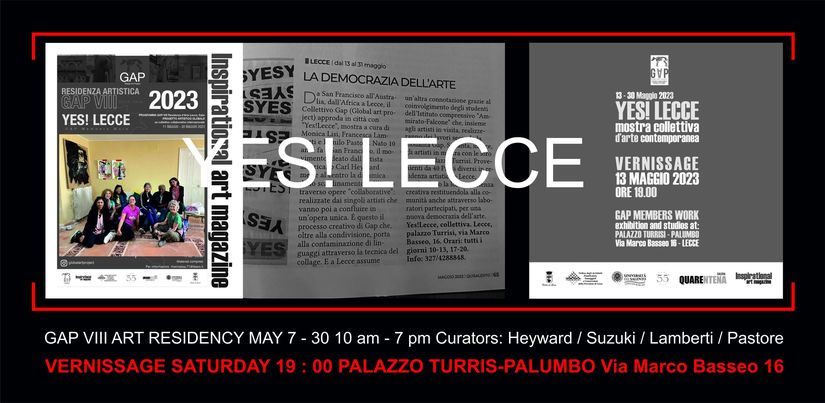






































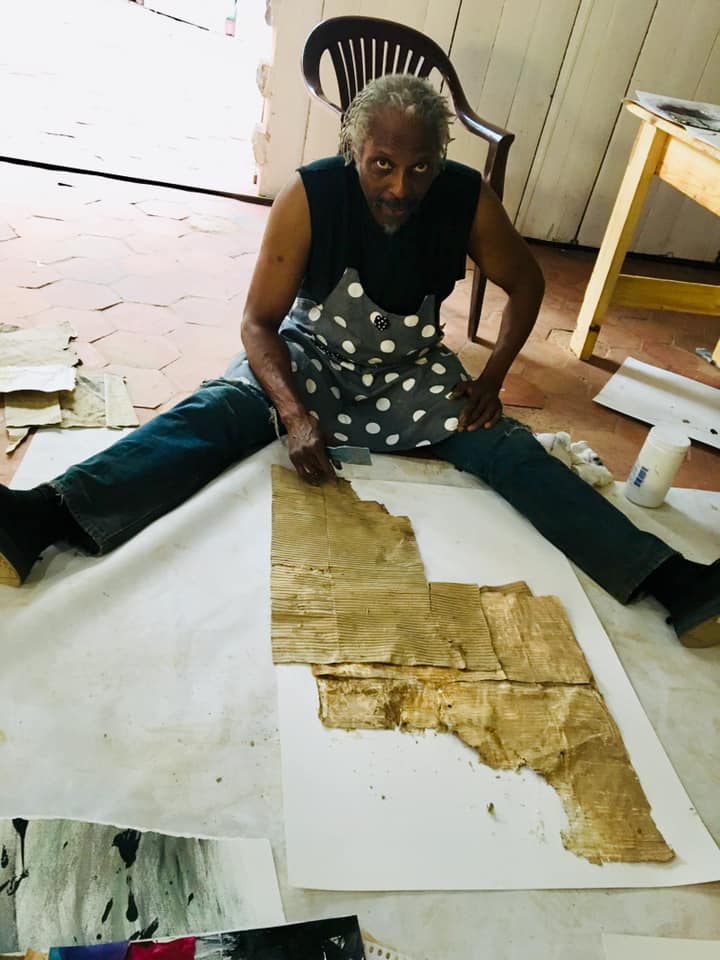

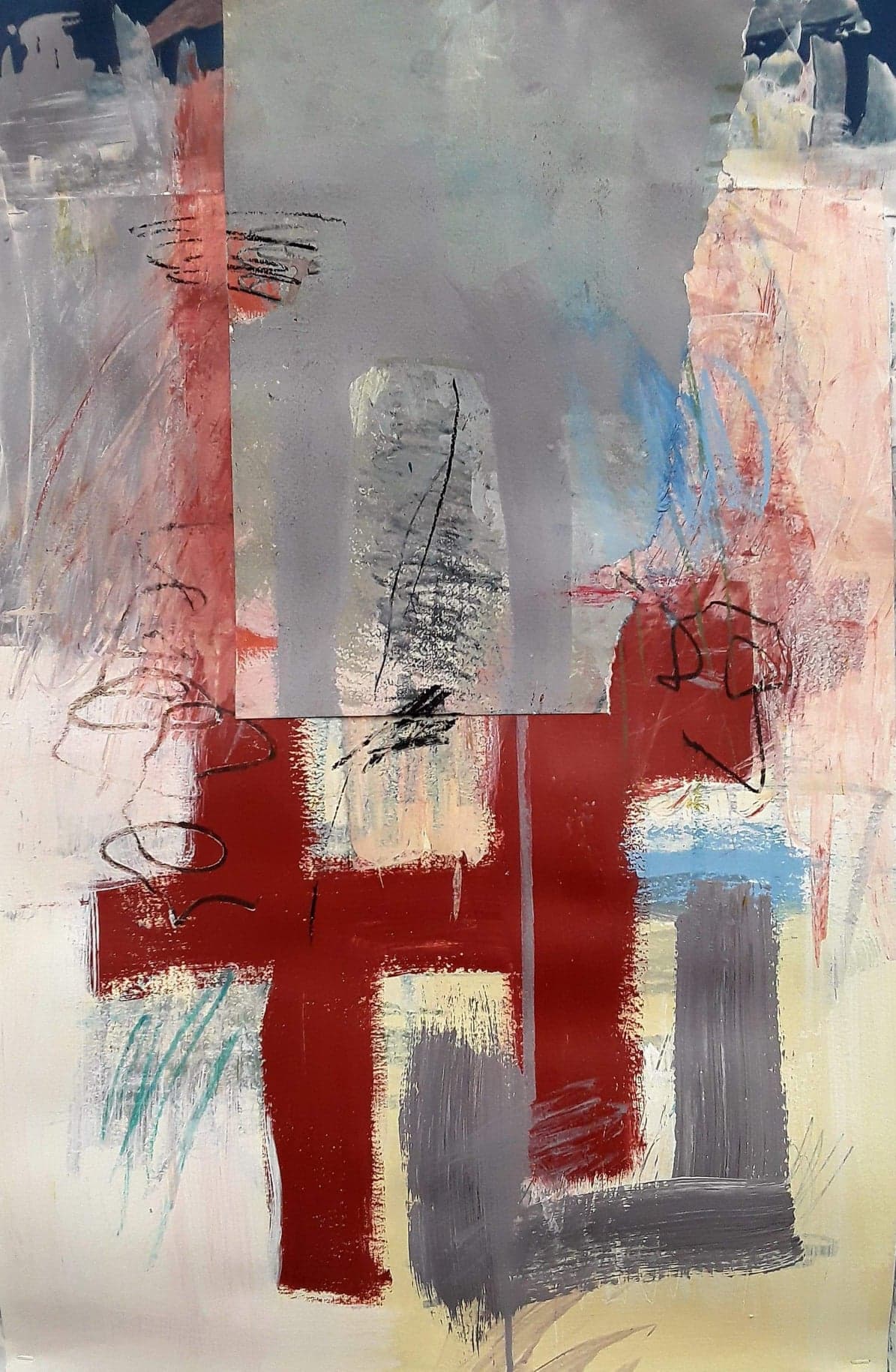



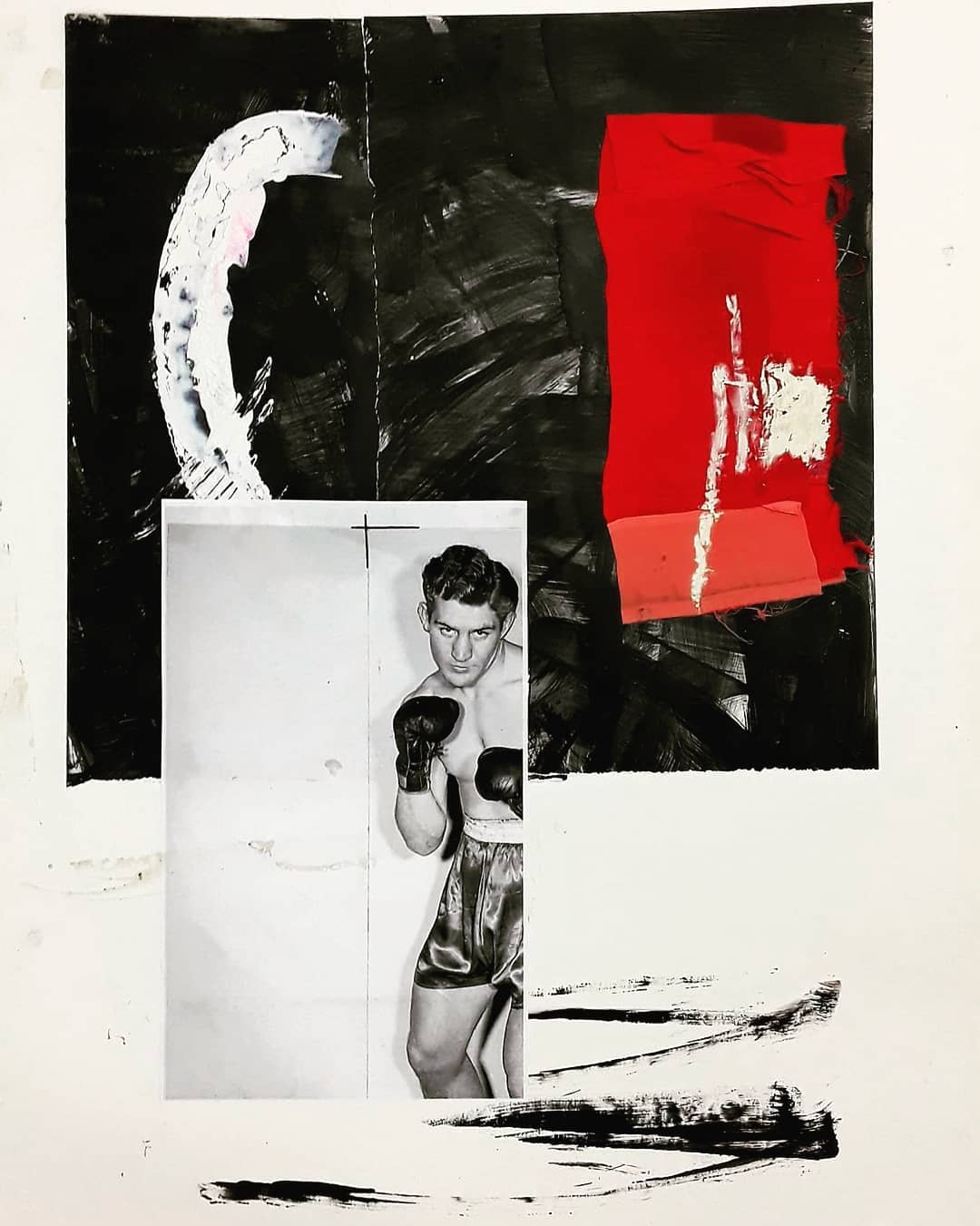 BOXER SERIES (matadore) :
BOXER SERIES (matadore) :


